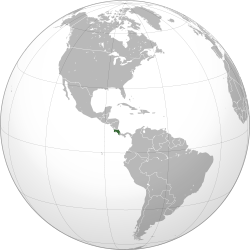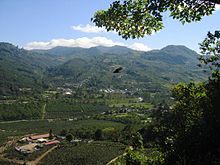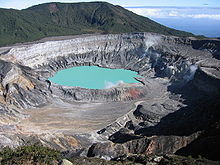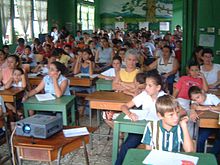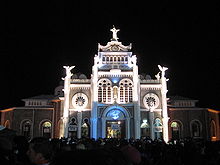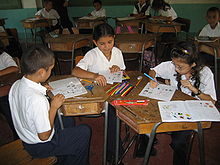- Costa Rica
-
For cities in other countries, see Costa Rica, Sinaloa and Costa Rica, Mato Grosso do Sul.
- For the plant genus Costa Rica, see its synonym Sicyos.
Republic of Costa Rica República de Costa Rica

Flag Coat of arms Motto: "Vivan siempre el trabajo y la paz" (Spanish)
"Long live work and peace"Anthem:
Noble patria, tu hermosa bandera (Spanish)
Noble homeland, your beautiful flagCapital
(and largest city)San José
9°56′N 84°5′W / 9.933°N 84.083°WOfficial language(s) Spanish Recognised regional languages Mekatelyu, Bribri Demonym Costa Rican; Tico Government Constitutional democracy
(Presidential republic)- President Laura Chinchilla - 1st Vice-President Alfio Piva - 2nd Vice-President Luis Liberman Independence Declared - from Spain September 15, 1821 - from Mexico (the First Mexican Empire) July 1, 1823 - from United Provinces of Central America March 21, 1847 - Recognized by Spain May 10, 1850 - Constitution November 7, 1949[1] Area - Total 51,100 km2 (128th)
19,653 sq mi- Water (%) 0.7 Population - June 2011 estimate 4,608,426[2] (123rd) - Density 89/km2 (107th)
220/sq miGDP (PPP) 2010 estimate - Total $51.166 billion[3] - Per capita $11,215[3] GDP (nominal) 2010 estimate - Total $35.780 billion[3] - Per capita $7,843[3] Gini (2009) 50[4] (high) HDI (2011) 0.744[5] (high) (69th) Currency Costa Rican colón ( CRC)Time zone UTC−06:00 (UTC-6) Drives on the right ISO 3166 code CR Internet TLD .cr Calling code +506 Costa Rica
 i/ˌkoʊstə ˈriːkə/, officially the Republic of Costa Rica (Spanish: Costa Rica or República de Costa Rica, pronounced: [reˈpuβlika ðe ˈkosta ˈrika]) is a multilingual, multiethnic and multicultural country in Central America, bordered by Nicaragua to the north, Panama to the southeast, the Pacific Ocean to the west and the Caribbean Sea to the east.
i/ˌkoʊstə ˈriːkə/, officially the Republic of Costa Rica (Spanish: Costa Rica or República de Costa Rica, pronounced: [reˈpuβlika ðe ˈkosta ˈrika]) is a multilingual, multiethnic and multicultural country in Central America, bordered by Nicaragua to the north, Panama to the southeast, the Pacific Ocean to the west and the Caribbean Sea to the east.Costa Rica, which means "Rich Coast", constitutionally abolished its army permanently in 1949.[6][7][8] It is the only Latin American country included in the list of the world's 22 older democracies.[9] Costa Rica has consistently been among the top Latin American countries in the Human Development Index (HDI), ranked 69th in the world in 2011.[5] Also was cited by the UNDP in 2010 as one of the countries that have attained much higher human development than other countries at the same income levels,[10] and in 2011 was highlighted by UNDP for being a good performer on environmental sustainability, and better record on human development and inequality than the median of their region. It was also the only country to meet all five criteria established to measure environmental sustainability.[5] The country is ranked third in the world, and first among the Americas, in terms of the 2010 Environmental Performance Index.[11]
In 2007, the Costa Rican government announced plans for Costa Rica to become the first carbon-neutral country by 2021.[12][13][14] According to the New Economics Foundation, Costa Rica ranks first in the Happy Planet Index and is the "greenest" country in the world.[15]
Contents
History
Main article: History of Costa RicaPre-Colombian period
Historians have classified the indigenous people of Costa Rica as belonging to the Intermediate Area, where the peripheries of the Mesoamerican and Andean native cultures overlapped. More recently, pre-Columbian Costa Rica has also been described as part of the Isthmo-Colombian region. The northwest of the country, Nicoya Peninsula, was the southernmost reach of the Nahuatl culture when the Spanish conquistadors arrived in the 16th century. The central and southern portions of the country had Chibcha influences.
The impact of the peoples on modern Costa Rican culture has been relatively small compared to other nations, since the country lacked a strong native civilization to begin with. Most of the native population was absorbed into the Spanish-speaking colonial society through miscegenation, except for some small remnants, the most significant of which are the Bribri and Boruca tribes who still inhabit the mountains of the Cordillera de Talamanca, in the southern part of Costa Rica, near the frontier with Panama.
Spanish colonization
During most of the colonial period, Costa Rica was the southernmost province of the Captaincy General of Guatemala, which was nominally part of the Viceroyalty of New Spain (i.e., Mexico), but which in practice operated as a largely autonomous entity within the Spanish Empire. Costa Rica's distance from the capital in Guatemala, its legal prohibition under Spanish law to trade with its southern neighbors in Panama, then part of the Viceroyalty of New Granada (i.e., Colombia), and the lack of resources, such as gold and silver, made Costa Rica into a poor, isolated, and sparsely inhabited region within the Spanish Empire.[16] Costa Rica was described as "the poorest and most miserable Spanish colony in all America" by a Spanish governor in 1719.[17]
Another important factor behind Costa Rica's poverty was the lack of a significant indigenous population available for forced labor, which meant most of the Costa Rican settlers had to work on their own land, preventing the establishment of large haciendas. For all these reasons, Costa Rica was by and large unappreciated and overlooked by the Spanish Crown and left to develop on its own. The circumstances during this period are believed to have led to many of the idiosyncrasies for which Costa Rica has become known, while concomitantly setting the stage for Costa Rica's development as a more egalitarian society than the rest of its neighbors. Costa Rica became a "rural democracy" with no oppressed mestizo or indigenous class. It was not long before Spanish settlers turned to the hills, where they found rich volcanic soil and a milder climate than that of the lowlands.[18]
Independence
Like the rest of Central America, Costa Rica never fought for independence from Spain. On September 15, 1821, after the final Spanish defeat in the Mexican War of Independence (1810–1821), the authorities in Guatemala declared the independence of all of Central America. That date is still celebrated as Independence Day in Costa Rica, even though, technically, under the Spanish Constitution of 1812 that had been readopted in 1820, Nicaragua and Costa Rica had become an autonomous province with its capital in León.
Like other Central Spanish nations, Costa Rica considered annexation to the short-lived First Mexican Empire of Agustín de Iturbide, but, after its collapse in 1823, Costa Rica became instead a province of the new Federal Republic of Central America, which theoretically existed from 1823 to 1839, but which exercised a very loose authority over its constituent provinces, particularly the poor and remote Costa Rica. In 1824, the Costa Rican capital was moved to San José, leading to a brief outburst of violence over rivalry with the old capital, Cartago. While civil wars raged both among the provinces of the Federal Republic of Central America and between political factions within individual provinces, Costa Rica remained largely at peace.
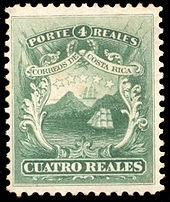 The 1849 national coat of arms was featured in the first postal stamp issued in 1862.
The 1849 national coat of arms was featured in the first postal stamp issued in 1862.
In 1838, long after the Federal Republic of Central America ceased to function in practice, Costa Rica formally withdrew and proclaimed itself sovereign. The considerable distance and poor communication routes between Guatemala City and the Central Plateau, where most of the Costa Rican population lived then and still lives now, meant the local population had little allegiance to the federal government in Guatemala. From colonial times to now, Costa Rica's reluctance to become politically tied with the rest of Central America has been a major obstacle to efforts for greater regional integration.
Economic growth
Coffee was first planted in Costa Rica in the early 19th century, and was first shipped to Europe in 1843, soon becoming Costa Rica's first major export. Coffee production would remain Costa Rica's principal source of wealth well into the 20th century. Most of the coffee exported was grown around the main centers of population in the Central Plateau and then transported by oxcart to the Pacific port of Puntarenas. Since the main market for the coffee was in Europe, it soon became a high priority to develop a transportation route from the Central Plateau to the Atlantic Ocean. For this purpose, in the 1870s, the Costa Rican government contracted with U.S. businessman Minor C. Keith to build a railroad to the Caribbean port of Limón. Despite enormous difficulties with construction, disease, and financing, the railroad was completed in 1890.
Most Afro-Costa Ricans, who constitute about 3% of the country's population, descend from Jamaican immigrants who worked in the construction of that railway.[19] United States convicts, Italians and Chinese immigrants also participated in the construction project. In exchange for completing the railroad, the Costa Rican government granted Keith large tracts of land and a lease on the train route, which he used to produce bananas and export them to the United States. As a result, bananas came to rival coffee as the principal Costa Rican export, while foreign-owned corporations (including the United Fruit Company) began to hold a major role in the national economy.[citation needed]
20th century
Historically, Costa Rica has generally enjoyed greater peace and more consistent political stability compared with many of its fellow Latin American nations. Since the late 19th century, however, Costa Rica has experienced two significant periods of violence. In 1917–19, General Federico Tinoco Granados ruled as a military dictator until he was overthrown and forced into exile. The unpopularity of Tinoco's regime led, after he was overthrown, to a considerable decline in the size, wealth, and political influence of the Costa Rican military. In 1948, José Figueres Ferrer led an armed uprising in the wake of a disputed presidential election between president Rafael Ángel Calderón Guardia and Otilio Ulate Blanco.[20] With more than 2,000 dead, the resulting 44-day Costa Rican Civil War was the bloodiest event in Costa Rica during the 20th century.
The victorious rebels formed a government junta that abolished the military altogether, and oversaw the drafting of a new constitution by a democratically elected assembly.[21] Having enacted these reforms, the junta relinquished its power on November 8, 1949, to the new democratic government. After the coup d'état, Figueres became a national hero, winning the country's first democratic election under the new constitution in 1953. Since then, Costa Rica has held 13 presidential elections, the latest in 2010. All of them have been widely regarded by the international community as peaceful and transparent.
Politics
Main article: Politics of Costa RicaProvinces, cantons, and districts
Main articles: Provinces of Costa Rica and Cantons of Costa RicaCosta Rica is composed of seven provinces, which in turn are divided into 81 cantons (Spanish: cantón, plural cantones), each of which is directed by a mayor. Mayors are chosen democratically every four years by each canton's people. There are no provincial legislatures. The cantons are further divided into 421 districts (distritos). The provinces are:
Geography
Main article: Geography of Costa RicaCosta Rica is located on the Central American isthmus, lying between latitudes 8° and 12°N, and longitudes 82° and 86°W. It borders the Caribbean Sea (to the east) and the Pacific Ocean (to the west), with a total of 1,290 kilometres (800 mi) of coastline, 212 km (132 mi) on the Caribbean coast and 1,016 km (631 mi) on the Pacific.
Costa Rica also borders Nicaragua to the north (309 km or 192 mi of border) and Panama to the south-southeast (639 km or 397 mi of border). In total, Costa Rica comprises 51,100 square kilometres (19,700 sq mi) plus 589 square kilometres (227 sq mi) of territorial waters.
The highest point in the country is Cerro Chirripó, at 3,819 metres (12,530 ft); it is the fifth highest peak in Central America. The highest volcano in the country is the Irazú Volcano (3,431 m or 11,257 ft). The largest lake in Costa Rica is Lake Arenal.
Costa Rica also comprises several islands. Cocos Island (24 square kilometres / 9.3 square miles) stands out because of its distance from continental landmass, 300 mi (480 km) from Puntarenas, but Calero Island is the largest island of the country (151.6 square kilometres / 58.5 square miles). Over 25% of Costa Rica's national territory is protected by SINAC (the National System of Conservation Areas), which oversees all of the country's protected areas. Costa Rica also possesses the greatest density of species in the world.[22]
See also: List of volcanoes in Costa Rica, Islands of Costa Rica, and Category:Waterfalls of Costa RicaClimate
Main article: Climate of Costa RicaBecause Costa Rica is located between 8 and 12 degrees north of the Equator, the climate is tropical year round. However, the country has many microclimates depending on elevation, rainfall, topography, and by the geography of each particular region.
Costa Rica's seasons are defined by how much rain falls during a particular period and not to the four seasons in the Northern Hemisphere. The year can be split into two periods, the dry season known to the residents as summer, and the rainy season, known locally as winter. The "summer" or dry season goes from December to April, and "winter" or rainy season goes from May to November, which almost coincides with the Atlantic hurricane season, and during this time, it rains constantly in some regions.
The location receiving the most rain is the Caribbean slopes of the Central Cordillera mountains, with an annual rainfall of over 5,000 mm (196.9 in). Humidity is also higher on the Caribbean side than on the Pacific side. The mean annual temperature on the coastal lowlands is around 27 °C (81 °F), 20 °C (68 °F) in the main populated areas of the Central Cordilera, and below 10 °C (50 °F) on the summits of the highest mountains.[23]
Costa Rica Weather Averages [24]
Months January February March April May June July August September October November December High Temperature (C) 27 27 28 28 27 27 27 27 26 26 26 26 Low Temperature (C) 17 18 18 18 18 18 18 18 17 18 18 18 Precipitation (mm) 6.3 10.2 13.8 79.9 267.6 280.1 181.5 276.9 355.1 330.6 135.5 33.5 Average Percent Sunshine 40 37 39 33 25 20 21 22 20 22 25 34 Economy
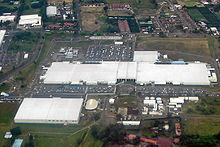 An Intel microprocessor facility in Costa Rica is responsible for 20% of Costa Rican exports and 5% of the country's GDP.
An Intel microprocessor facility in Costa Rica is responsible for 20% of Costa Rican exports and 5% of the country's GDP. Main articles: Economy of Costa Rica and Tourism in Costa Rica
Main articles: Economy of Costa Rica and Tourism in Costa RicaAccording to the World Bank, Costa Rica's GDP per capita is US$11,122 PPP (as of 2009); however, this developing country still faces the fourth-highest inflation rate in Latin America, lack of maintenance and new investment in infrastructure, a poverty rate estimated to be 5% to 8%,[25][26] a 7.8% unemployment rate (2009 est.),[25] and a trade deficit of 5.2%. For the fiscal year 2007, the country showed a government surplus. Economic growth in 2008 diminished to a 3% increase in the face of a global recession (down from 7% and 9% growth in the prior two years).[25][27]
Costa Rica's inflation rate was an estimated 9.3% in 2007 and increased to 13.9% in 2008, Latin America's fourth-highest inflation rate for both years.[25] On October 16, 2006, a new currency exchange system was introduced, allowing the value of the CRC colón to float between two bands as done previously by Chile. This policy's objective was to allow the Central Bank to be able to better tackle inflation and discourage the use of U.S. dollars. However, as of August 2009, the value of the colón against the dollar has decreased to 86% of its late-2006 value (see commonly available forex trading charts). The unit of currency is the colón, and as of October 2010, it trades around 507 to the U.S. dollar,[28] and about 705 colones to the euro.
The central government offers tax exemptions for those willing to invest in the country. Several global high tech corporations have already started developing in the area and are exporting goods, including chip manufacturer Intel, pharmaceutical company GlaxoSmithKline, and consumer products company Procter & Gamble. In 2006, Intel's microprocessor facility alone was responsible for 20% of Costa Rican exports and 4.9% of the country's GDP.[29][30] Trade with Southeast Asia and Russia boomed during 2004 and 2005, and the country obtained full Asia-Pacific Economic Cooperation Forum (APEC) membership in 2007 after becoming an observer in 2004. The Financial Times Intelligent Unit awarded Costa Rica with the fDi’s Caribbean and Central American Country of the Future 2011/12 for its successful record in attracting FDI into the country, and being the number one destination country in the region in terms of foreign direct investment (FDI) project numbers since 2003.[31][32]
In recent times, pharmaceuticals, financial outsourcing, software development, and ecotourism have become the prime industries in Costa Rica's economy. High levels of education among its residents make the country an attractive investing location. Since 1999, tourism earns more foreign exchange than the combined exports of the country's three main cash crops: bananas, pineapples and coffee.[33] Coffee production has played a key role in Costa Rica's history and economy, and by 2006, was the third cash crop export.[33]
The largest coffee growing areas are in the provinces of San José, Alajuela, Heredia, Puntarenas, and Cartago. Costa Rica is famous for its gourmet coffee beans, with Costa Rican Tarrazú among the finest arabica coffee beans in the world used for making espresso coffee, together with Jamaican Blue Mountain, Guatemalan Antigua and Ethiopian Sidamo.[34][35][36][37]
Costa Rica's location provides access to American markets as it has the same time zone as the central part of the United States and direct ocean access to Europe and Asia. In a countrywide referendum on October 5, 2007, the voters of Costa Rica narrowly backed a free trade agreement, with 51.6% of "Yes" votes.[38]
With a $2.2 billion per year tourism industry, Costa Rica is the most visited nation in the Central American region, with two million foreign visitors in 2008,[39] which translates into a relatively high expenditure per tourist of $1,077 per trip, one of the highest in the Caribbean Basin. In 2008, most visitors came from the United States (38.6%), neighboring Nicaragua (21.8%), Europe (11.3%) and Canada (5.2%).[40] In 2005, tourism contributed 8.1% of the country's GNP, and represented 13.3% of direct and indirect employment.[41] Tourism now earns more foreign exchange than bananas and coffee combined.[33][42]
Ecotourism draws many tourists to visit the extensive national parks and protected areas around the country. Costa Rica was a pioneer in this type of tourism, and the country is recognized as one of the few with true ecotourism.[43] In terms of the 2011 Travel and Tourism Competitiveness Index, Costa Rica ranked 44th in the world and second among Latin American countries after Mexico.[44] Considering its subindex natural resources, Costa Rica ranks sixth worldwide in the natural resources pillar, but 104th in terms of its cultural resources due to the country's limited number of cultural sites.[44]
Costa Rica has also developed a system of payments for environmental services.[45] Similarly, Costa Rica has a tax on water pollution to penalize businesses and homeowners that dump sewage, agricultural chemicals, and other pollutants into waterways.[46] In May 2007, the Costa Rican government announced its intentions to become 100 percent carbon neutral before 2030.[47] As of 2010, Costa Rica is well on its way towards accomplishing this goal, currently producing 90 percent of its electricity through renewable sources.[48]
In 1996, the Forest Law was enacted to provide direct financial incentives to landowners for the provision of environmental services.[45] This helped reorient the forestry sector away from commercial timber production and the resulting deforestation, and helped create awareness of the services it provides for the economy and society (i.e. carbon fixation, hydrological services such as producing fresh drinking water, biodiversity protection, and provision of scenic beauty).[45]
Foreign relations
Main article: Foreign relations of Costa RicaCosta Rica is an active member of the United Nations and the Organization of American States. The Inter-American Court of Human Rights and the United Nations University of Peace are based in Costa Rica. It is also a member of many other international organizations related to human rights and democracy.
A main foreign policy objective of Costa Rica is to foster human rights and sustainable development as a way to secure stability and growth.[49]
Costa Rica is a member of the International Criminal Court, without a Bilateral Immunity Agreement of protection for the United States military (as covered under Article 98).
On 10 September 1961, some months after Fidel Castro declared Cuba a socialist state, Costa Rican President Mario Echandi ended diplomatic relations with Cuba through Executive Decree Number 2. This freeze lasted for 47 years until President Óscar Arias Sánchez announced on 18 March 2009 that normal relations were to be re-established, saying, "If we have been able to turn the page with regimes as profoundly different to our reality as occurred with the USSR or, more recently, with the Republic of China, how would we not do it with a country that is geographically and culturally much nearer to Costa Rica?" Arias also announced both countries would exchange ambassadors.[50]
Costa Rica also has a long-term disagreement with Nicaragua over the San Juan River, which defines the border between the two countries. This disagreement arises regarding Costa Rica's rights of navigation on the river.[51] In 2010, there was also a dispute around Isla Calero, and the impact of Nicaraguan dredging of the river in that area.[52]
On July 14, 2009, the Hague(ICJ) court upheld the rights Costa Ricans had to navigate for commercial purposes to subsistence fishing on their side of the river. An 1858 treaty extended navigation rights to Costa Rica, but Nicaragua denied passenger travel and fishing were part of the deal; the court ruled Costa Ricans on the river were not required to have Nicaraguan tourist cards or visas as Nicaragua alleged, but, in a nod to the Nicaraguans, ruled Costa Rican boats and passengers must stop at the first and last Nicaraguan port along their route. They must also have an identity document or passport. Nicaragua can also impose timetables on Costa Rican traffic. Nicaragua may require Costa Rican boats to display the flag of Nicaragua, but may not charge them for departure clearance from its ports. These were all specific items of contention brought to the court in the 2005 filing.[53]
On June 1, 2007, Costa Rica broke diplomatic ties with the Republic of China in Taiwan, switching recognition to the People's Republic of China. Costa Rica was the first of the Central American nations to do so. President Óscar Arias Sánchez admitted the action was a response to economic exigency.[54] In appreciation, the PRC built Costa Rica a new, $100 million, state-of-the-art football stadium in Parque la Sabana, in the province of San José. Approximately 600 Chinese engineers and laborers took part in this project, and it was inaugurated in March 2011, with a match between the Costa Rica and China national teams.
Costa Rica finished a term on the United Nations Security Council, having been elected for a nonrenewable, two-year term in the 2007 election. Its term expired on 31 December 2009; this was Costa Rica's third time on the Security Council.
Flora and fauna
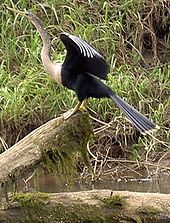 An anhinga drying its feathers
An anhinga drying its feathers See also: Wildlife of Costa Rica and List of birds of Costa Rica
See also: Wildlife of Costa Rica and List of birds of Costa RicaCosta Rica is home to a rich variety of plants and animals. While the country has only about 0.25% of the world's landmass, it contains 5% of the world's biodiversity.[55][56] Around 25% of the country's land area is in protected national parks and protected areas,[57][58] the largest percentage of protected areas in the world (developing world average 13%, developed world average 8%).[45][59][60] Costa Rica has successfully managed to diminish deforestation from some of the worst rates in the world from 1973 to 1989, to almost zero by 2005.[45]
One national park, the Corcovado National Park, is internationally renowned among ecologists for its biodiversity (including big cats and tapirs) and is where visitors can expect to see an abundance of wildlife.[61][62] Corcovado is the one park in Costa Rica where all four Costa Rican monkey species can be found.[63] These include the white-headed capuchin, the mantled howler,the endangered Geoffroy's spider monkey[63][64] and the Central American squirrel monkey, found only on the Pacific coast of Costa Rica and a small part of Panama, and considered endangered until 2008, when its status was upgraded to vulnerable. Deforestation, illegal pet-trading, and hunting are the main reasons for its threatened status.[65]
 Costa Rican colibrí
Costa Rican colibrí
Tortuguero National Park—the name Tortuguero can be translated as "Full of Turtles"—is home to spider, howler and white-throated capuchin monkeys; the three-toed sloth and two-toed sloth; 320 species of birds; and a variety of reptiles. The park is recognized for the annual nesting of the endangered green turtle, and is the most important nesting site for the species. Giant leatherback, hawksbill, and loggerhead turtles also nest there.
The Monteverde Cloud Forest Reserve is home to about 2,000 plant species,[66] including numerous orchids. Over 400 types of birds and over 100 species of mammals can be found there.[66]
As a whole, around 700 species of birds have been identified in Costa Rica. The Instituto Nacional de Biodiversidad is allowed to collect royalties on any biological discoveries of medical importance.
Costa Rica is a center of biological diversity for reptiles and amphibians, including the world's fastest running lizard, the spiny-tailed iguana (Ctenosaura similis).[67]
Demographics
Main article: Demographics of Costa RicaCosta Rican Censuses Year Population %± 1864 120,499 — 1883 182,073 51.1 1892 243,205 33.6 1927 471,524 93.9 1950 800,875 69.8 1963 1,336,274 66.9 1973 1,871,780 40.1 1984 2,416,809 29.1 2000 3,824,593 58.2 2011 4,605,766 * 20.4 * (* pre-census estimate)
Data sources: [68] [69]As of 2010, Costa Rica has an estimated population of 4,640,000.[70] Whites and mestizos make up 94% of the population, whites being 80% and mestizos 14%,[71] while 3% are Black, or Afro-Caribbean, 1% Native American, 1% Chinese, and 1% other.[72]
There are also over 60,000 Native American or indigenous inhabitants, representing 1.5% of the population. Most of them live in secluded reservations, distributed among eight ethnic groups: Quitirrisí (in the Central Valley), Matambú or Chorotega (Guanacaste), Maleku (northern Alajuela), Bribri (southern Atlantic), Cabécar (Cordillera de Talamanca), Guaymí (southern Costa Rica, along the Panamá border), Boruca (southern Costa Rica) and Térraba (southern Costa Rica).
The population of European ancestry is primarily of Spaniard descent,[73] with significant numbers of Italian, German, English, Dutch, French, Irish, Portuguese, Lebanese and Polish families, as well a sizable Jewish community. The majority of the Afro-Costa Ricans are Creole English-speaking descendants of 19th century black Jamaican immigrant workers.
The 2000 census classified 94% of the population as white or mestizo and less than 3% as black or Amerindian. Native and European mixed blood populations are far less than in other Latin American countries. Exceptions are Guanacaste, where almost half the population is visibly mestizo, a legacy of the more pervasive unions between Spaniards colonists and Chorotega Amerindians through several generations, and Limón, where the vast majority of the Afro-Costa Rican community lives.
Costa Rica hosts many refugees, mainly from Colombia and Nicaragua. As a result of that and illegal immigration, an estimated 10–15% (400,000–600,000) of the Costa Rican population is made up of Nicaraguans.[74][75] Some Nicaraguans migrate for seasonal work opportunities and then return to their country. Costa Rica took in many refugees from a range of other Latin American countries fleeing civil wars and dictatorships during the 1970s and 80s, notably from Chile and Argentina, as well as people from El Salvador who fled from guerrillas and government death squads.[76]
According to the World Bank, in 2010 about 489,200 immigrants lived in the country, mainly from Nicaragua, Panama, El Salvador, Honduras, Guatemala, and Belize, while 125,3060 Costa Ricans live abroad in the United States, Panama, Nicaragua, Spain, Mexico, Canada, Germany, Venezuela, Dominican Republic, and Ecuador.[77]
Health
The World Bank estimates the life expectancy at birth for Costa Ricans in 2008 is 79 years, a figure unchanged since 2005.[78] The Nicoya Peninsula is considered one of the Blue Zones in the world, where people commonly live active lives past the age of 100 years.[79][80]
In 2002, there were 0.58 new general practitioner consultations and 0.33 new specialist consultations per capita, and a hospital admission rate of 8.1%. Preventive health care is also successful. In 2002, 96% of Costa Rican women used some form of contraception, and antenatal care services were provided to 87% of all pregnant women. All children under one have access to well-baby clinics, and the immunization coverage rate in 2002 was above 91% for all antigens.[citation needed] Costa Rica has a very low malaria incidence of 48 per 100,000 in 2000 and no reported cases of measles in 2002. The perinatal mortality rate dropped from 12.0 per 1000 in 1972 to 5.4 per 1000 in 2001.[81]
Costa Rica has been cited in various journals as Central America's great health success story.[citation needed] Its healthcare system is ranked higher than that of the United States, despite having a fraction of its GDP.[82] Prior to 1940, government hospitals and charities provided most health care delivery. But since the 1941 creation of the Social Security Administration (Caja Costarricense de Seguro Social – CCSS), Costa Rica has provided universal health care to its wage-earning residents, with coverage extended to dependants over time. In 1973, the CCSS took over administration of all 29 of the country's public hospitals and all health care, also launching a Rural Health Program (Programa de Salud Rural) for primary care to rural areas, later extended to primary care services nationwide. In 1993, laws were passed to enable elected health boards that represented health consumers, social security representatives, employers, and social organizations. By the year 2000, social health insurance coverage was available to 82% of the Costa Rican population. Each health committee manages an area equivalent to one of the 83 administrative cantons of Costa Rica. There is limited use of private, for-profit services (around 14.4% of the national total health expenditure). About 7 % of GDP is allocated to the health sector, and over 70% is government funded. There are some threats to the universal health care model.
Primary health care facilities in Costa Rica include health clinics, with a general practitioner, nurse, clerk, pharmacist and a primary health technician. In 2008, there were five specialty national hospitals, three general national hospitals, seven regional hospitals, 13 peripheral hospitals, and 10 major clinics serving as referral centers for primary care clinics, which also deliver biopsychosocial services, family and community medical services and promotion and prevention programs. Patients can choose private health care to avoid waiting lists.[citation needed]
Costa Rica is among the Latin America countries that have became popular destinations for medical tourism.[83][84] In 2006, Costa Rica received 150,000 foreigners that came for medical treatment.[83][84][85] Costa Rica is particularly attractive to American tourists because of its proximity and short flight, the quality of medical services, and lower medical costs.[84]
Religion
Main article: Religion in Costa RicaChristianity is the predominant religion, and Roman Catholicism is the official state religion according to the 1949 Constitution, which at the same time guarantees freedom of religion.
According to the most recent nationwide survey of religion, conducted in 2007 by the University of Costa Rica, 70.5% of Costa Ricans are Roman Catholics, 44.9% of the population are practicing Catholics, 13.8% are Evangelical Protestants, 11.3% report they do not have a religion, and 4.3% belonged to another.
Because of the recent small but continuous immigration from Asia and the Middle East, other religions have grown, the most popular being Buddhism (because of a growing Chinese community of 40,000), and smaller numbers of Hindu, Jewish, Bahá’í, and Muslim adherents.
The Sinagoga Shaarei Zion synagogue [86] is near La Sabana Metropolitan Park in San José. Several homes in the neighborhood east of the park display the Star of David and other Jewish symbols.[87]
The Church of Jesus Christ of Latter-day Saints (Mormons) claim more than 35,000 members, and has a temple in San Jose that served as a regional worship center for Costa Rica, Panama, Nicaragua, and Honduras.[88] However, they represent less than one percent of the population.[89][90]
Languages
Main article: Languages of Costa RicaThe primary language spoken in Costa Rica is Spanish. Some native languages are still spoken in indigenous reservations. The most numerically important are the Bribri, Maléku, Cabécar and Ngäbere languages, some of which have several thousand speakers in Costa Rica – others a few hundred. Some languages, such as Teribe and Boruca, have fewer than a thousand speakers. A Creole-English language, Jamaican patois (also known as Mekatelyu), is spoken along the Caribbean coast. About 10.7% of Costa Rica's adult population (18 or older) also speaks English, 0.7% French, and 0.3% speaks Portuguese or German as a second language.[91]
Culture
Main article: Culture of Costa RicaSee also: Costa Rican cuisine Costa Rican breakfast with gallo pinto
Costa Rican breakfast with gallo pinto
Costa Rica was the point where the Mesoamerican and South American native cultures met. The northwest of the country, the Nicoya peninsula, was the southernmost point of Nahuatl cultural influence when the Spanish conquerors (conquistadores) came in the 16th century. The central and southern portions of the country had Chibcha influences. The Atlantic coast, meanwhile, was populated with African workers during the 17th and 18th centuries.
Costa Rican cuisine is a blend of Native American, Spanish, African and many other cuisine origins. Dishes such as the very traditional tamale and many others made of corn are the most representative of its indigenous inhabitants, and similar to other neighboring Mesoamerican countries. Spaniards brought many new ingredients to the country from other lands, especially spices and domestic animals. And later in the 19th century, the African flavor lent its presence with influence from other Caribbean mixed flavors. This is how Costa Rican cuisine today is very varied, with every new ethnic group who had recently become part of the country's population influencing the country's cuisine.[92][unreliable source?]
As a result of the immigration of Spaniards, their 16th century Spanish culture and its evolution marked everyday life and culture until today, with Spanish language and the Catholic religion as primary influences.
The Department of Culture, Youth, and Sports is in charge of the promotion and coordination of cultural life. The work of the department is divided into Direction of Culture, Visual Arts, Scenic Arts, Music, Patrimony and the System of Libraries. Although the department creates many initiatives, they are constrained by lack of resources.[citation needed] Permanent programs, such as the National Symphony Orchestra of Costa Rica and the Youth Symphony Orchestra, are conjunctions of two areas of work: Culture and Youth.[citation needed]
Dance-oriented genres, such as soca, salsa, bachata, merengue, cumbia and Costa Rican swing are enjoyed increasingly by older rather than younger people. The guitar is popular, especially as an accompaniment to folk dances; however, the marimba was made the national instrument.
"Pura Vida" is the most recognizable phrase attached to Costa Ricans, and it reflects the Costa Rican way of life. Often, people walking down the streets, or buying food at shops say hello by saying "Pura Vida", which means pure life, or good life. It can be phrased as a question or as an acknowledgement of one's presence. A recommended response to "How are you?" would be "Pura Vida".[citation needed]
Education
Main article: Education in Costa RicaThe literacy rate in Costa Rica is 94.9%,[93] one of the highest in the world. When the army was abolished in 1949, it was said that the "army would be replaced with an army of teachers."[citation needed] Elementary and high schools are found throughout the country in practically every community. Universal public education is guaranteed in the constitution. Primary education is obligatory, and both preschool and high school are free. There are only a few schools in Costa Rica that go beyond the 12th grade. Students who finish 11th grade receive a Costa Rican Bachillerato Diploma accredited by the Costa Rican Ministry of Education.
There are both state and private universities, with the public universities being regarded as the best in the country, as well as being one of the best means of social mobility, given the large proportion of the budget spent to subsidize students from poor families. The University of Costa Rica has been awarded the title "Meritorious Institution of Costa Rican Education and Culture". In recent years, many private universities and colleges have consolidated because demand for higher education exceeds places available in the public sector.
See also
- Outline of Costa Rica
- Index of Costa Rica-related articles
- International rankings of Costa Rica
- List of countries without armed forces
- List of soccer clubs in Costa Rica
- Public Finances in Costa Rica
References
- ^ Central Intelligence Agency (2011). "Costa Rica". The World Factbook. Langley, Virginia: Central Intelligence Agency. https://www.cia.gov/library/publications/the-world-factbook/geos/cs.html. Retrieved 2011-10-04.
- ^ Estimación para el día de hoy 21 de Junio de 2011 Centro Centroamericano de Población, Universidad de Costa Rica. 2011-06-21.
- ^ a b c d "Costa Rica". International Monetary Fund. http://www.imf.org/external/pubs/ft/weo/2011/01/weodata/weorept.aspx?pr.x=81&pr.y=19&sy=2008&ey=2011&scsm=1&ssd=1&sort=country&ds=.&br=1&c=238&s=NGDPD%2CNGDPDPC%2CPPPGDP%2CPPPPC%2CLP&grp=0&a=. Retrieved 2011-04-21.
- ^ "Gini Index". World Bank. http://data.worldbank.org/indicator/SI.POV.GINI/. Retrieved 2011-03-02.
- ^ a b c UNDP Human Development Report 2011. "Table 1: Human Development Index and its components". UNDP. http://hdr.undp.org/en/media/HDR_2011_EN_Complete.pdf. Retrieved 2011-11-03. pp. 4, 42 (see Table 2.4 and Box 2.10) and 128
- ^ El Espíritu del 48. "Abolición del Ejército" (in Spanish). http://www.elespiritudel48.org/docu/h013.htm. Retrieved 2008-03-09.
- ^ "Costa Rica". World Desk Reference. http://dev.prenhall.com/divisions/hss/worldreference/CR/defense.html. Retrieved 2009-06-09.
- ^ "Costa Rica". Uppsala University. http://www.ucdp.uu.se/gpdatabase/gpcountry.php?id=39®ionSelect=4-Central_Americas. Retrieved 2009-06-09.
- ^ "Costa Rica's new president: Thriller for Chinchilla". The Economist. 2010-02-11. http://www.economist.com/world/americas/displaystory.cfm?story_id=15501885&fsrc=rss. Retrieved 2010-02-16.
- ^ UNDP Human Development Report 2010. "Table 1: Human development index 2010 and its components" (PDF). UNDP. http://hdr.undp.org/en/media/HDR_2010_EN_Complete.pdf. Retrieved 2010-11-06. pp. 5, 49 and 144
- ^ Yale Center for Environmental Law & Policy / Center for International Earth Science Information Network at Columbia University. "2010 Environmental Performance Index". http://epi.yale.edu/Home. Retrieved 2010-01-27.
- ^ John Burnett (2008-02-18). "Costa Rica Aims to Be a Carbon-Neutral Nation". National Public Radio (NPR.org). http://www.npr.org/templates/story/story.php?storyId=19141333. Retrieved 2009-04-27.
- ^ Alana Herro (2007-03-12). "Costa Rica Aims to Become First "Carbon Neutral" Country". Worldwatch Institute. http://www.worldwatch.org/node/4958. Retrieved 2009-04-27.
- ^ Alejandro Vargas (2007-02-21). "País quiere ser primera nación con balance neutro de carbono" (in Spanish). La Nación. http://www.nacion.com/ln_ee/2007/febrero/21/aldea1002694.html. Retrieved 2009-04-27.
- ^ Ashley Seager (2008-07-04). "Costa Rica is the world's happiest and greenest country in the world.". London: Guardian.co.uk. http://www.guardian.co.uk/environment/2009/jul/04/costa-rica-happy-planet-index. Retrieved 2009-07-04.
- ^ Claudia Quirós. La Era de la Encomienda. Historia de Costa Rica. Editorial de la Universidad de Costa Rica. 1990..
- ^ Shafer, D. Michael (1994). Winners and losers: how sectors shape the developmental prospects of states. Ithaca, N.Y.: Cornell University Press. ISBN 0-8014-8188-0.
- ^ "Costa Rica – Cartago". Costarica.com. 2009-05-22. http://www.costarica.com/Destinations/Cities-and-Towns/Cartago/. Retrieved 2010-06-26.
- ^ "Blacks of Costa Rica". World Culture Encyclopedia. http://www.everyculture.com/Middle-America-Caribbean/Blacks-of-Costa-Rica.html. Retrieved 2007-11-23.
- ^ See Ian Holzhauer, "The Presidency of Calderón Guardia" (University of Florida History Thesis, 2004)
- ^ "The Happiest People". The New York Times. January 6, 2010.
- ^ "estudiofi". Inbio.ac.cr. http://www.inbio.ac.cr/es/biod/estrategia/estudio.html. Retrieved 2010-06-26.
- ^ Eggar, Marc. "Climate/Weather". http://www.worldheadquarters.com/cr/climate/. Retrieved 28 June 2011.
- ^ "Costa Rica Weather". Costa Rica Guides
- ^ a b c d "Rank Order – Inflation rate (consumer prices)". CIA World Factbook. https://www.cia.gov/library/publications/the-world-factbook/geos/cs.html. Retrieved 2008-02-14.
- ^ http://hdr.undp.org/en/media/HDI_2008_EN_Tables.pdf
- ^ "Costa Rica: Economy". U.S. State Department. http://www.state.gov/r/pa/ei/bgn/2019.htm. Retrieved 2007-11-02.
- ^ "Tipo cambio de compra y de venta del dĂłlar de los Estados Unidos de AmĂŠrica". Indicadoreseconomicos.bccr.fi.cr. http://indicadoreseconomicos.bccr.fi.cr/indicadoreseconomicos/Cuadros/frmVerCatCuadro.aspx?idioma=1&CodCuadro=%20400. Retrieved 2010-06-26.
- ^ "Intel supone el 4,9 por ciento del PIB de Costa Rica" (in Spanish). El Economista. 2006-10-06. http://eleconomista.es/empresas-finanzas/noticias/81837/10/06/Intel-supone-el-49-por-ciento-del-PIB-de-Costa-Rica.html. Retrieved 2008-04-13.
- ^ "Intel fabrica el procesador "más veloz del mundo" en Costa Rica" (in Spanish). La Vanguardia. 2007-11-13. http://www.lavanguardia.es/premium/publica/publica?COMPID=53410660334&ID_PAGINA=22088&ID_FORMATO=9&turbourl=false. Retrieved 2008-04-13.
- ^ Jacqueline Walls (2011-08-11). "Caribbean and Central American Countries of the Future 2011/12". Financial Times Intelligent Unit. http://www.fdiintelligence.com/Locations/Americas/Caribbean-and-Central-American-Countries-of-the-Future-2011-12. Retrieved 2011-08-23.
- ^ "Costa Rica lidera ranquin regional de atracción de inversiones" (in Spanish). La Nación. 2011-08-22. http://www.nacion.com/2011-08-23/Economia/costa-rica-lidera-ranquin-regional-de-atraccion--de-inversiones--.aspx. Retrieved 2011-08-23.
- ^ a b c Departamento de Estadísticas ICT (2006). "Anuário Estadísticas de Demanda 2006" (in Spanish) (PDF). Intituto Costarricense de Turismo. http://www.visitcostarica.com/ict/backoffice/treeDoc/files/Anuario%20de%20Turismo%202006%20(VERSION%20FINAL).pdf. Retrieved 2008-07-29. Table 44 and 45
- ^ Revista VEJA (2008-07-31). "Os melhores grãos do mundo" (in Portuguese). Editora Abril. http://veja.abril.com.br/300708/p_140.shtml. Retrieved 2008-07-29. Edition 2071. Print edition pp. 140
- ^ Betty Fussell (1999-09-05). "The World Before Starbucks". The New York Times. http://query.nytimes.com/gst/fullpage.html?res=9400E0D7173BF936A3575AC0A96F958260&sec=&spon=&pagewanted=2. Retrieved 2008-07-29.
- ^ Florence Fabricant (1992-09-02). "Americans Wake Up and Smell the Coffee". The New York Times. http://query.nytimes.com/gst/fullpage.html?res=9E0CE3DB153FF931A3575AC0A964958260&sec=&spon=&pagewanted=1. Retrieved 2008-07-29.
- ^ "Ferris Gourmet Coffee Beans: Single origin coffees". Ferris Coffee & Nuts. Archived from the original on March 20, 2008. http://web.archive.org/web/20080320064833/http://www.ferriscoffee.com/coffee.html. Retrieved 2008-07-29.
- ^ "Latinamerica Press". Latinamerica Press. Archived from the original on May 10, 2008. http://web.archive.org/web/20080510105108/http://www.latinamericapress.org/article.asp?lanCode=1&artCode=5348. Retrieved 2010-06-26.
- ^ Hassel Fallas (2008-12-18). "Llegada de turistas dejará $2.200 millones este año" (in Spanish). La Nación. http://www.nacion.com/ln_ee/2008/diciembre/18/economia1815172.html. Retrieved 2009-04-27.
- ^ Departamento de Estadísticas ICT (2009). "Anuário Estadístico 2008" (in Spanish) (PDF). Intituto Costarricense de Turismo. http://www.visitcostarica.com/ict/paginas/modEst/estudios_estadisticas.asp?idIdioma=2. Retrieved 2008-09-05.
- ^ Altés, Carmen (2006). "El Turismo en América Latina y el Caribe y la experiencia del BID". Inter-American Development Bank; Sustainable Development Department, Technical Paper Series ENV-149, Washington, D.C. available at http://idbdocs.iadb.org/wsdocs/getdocument.aspx?docnum=984876.+p. 9 and 47.
- ^ José Enrique Rojas (2004-12-29). "Turismo, principal motor de la economía durante el 2004" (in Spanish). La Nación. http://www.nacion.com/ln_ee/2004/diciembre/29/economia0.html. Retrieved 2008-04-13.
- ^ Honey, Martha (1999). Ecotourism and Sustainable Development: Who Owns Paradise?. Island Press; 1 edition, Washington, D.C.. p. 5. ISBN 1-55963-582-7.
- ^ a b Jennifer Blanke and Thea Chiesa, Editors (2011). "Travel & Tourism Competitiveness Report 2011". World Economic Forum, Geneva, Switzerland. http://www3.weforum.org/docs/WEF_TravelTourismCompetitiveness_Report_2011.pdf. Retrieved 2011-03-14.
- ^ a b c d e Jessica Brown and Neil Bird 2010. Costa Rica sustainable resource management: Successfully tackling tropical deforestation. London: Overseas Development Institute
- ^ "Costa Rica taxing firms that dump wastewater into rivers,” EFE News Service, April 7, 2009.
- ^ Sawin, Janet L. (2007-11-07). ": Bright Green: Costa Rica and New Zealand on Path to Carbon Neutrality". Worldchanging. http://www.worldchanging.com/archives/007549.html. Retrieved 2011-05-05.
- ^ "Costa Rica Nears Carbon-Neutral Goal". Carbonoffsetsdaily.com. 2010-07-31. http://www.carbonoffsetsdaily.com/news-channels/global/costa-rica-nears-carbon-neutral-goal-40863.htm. Retrieved 2011-11-02.
- ^ "Costa Rican Ministry of International Relations Declaration of Objectives". Costa Rican Ministry of International relations. http://www.rree.go.cr/?sec=ministerio&cat=politica%20exterior. Retrieved 2011-04-23.
- ^ Costa Rica re-establishes ties with Cuba CNN World, 2009-03-18.
- ^ "IJC Court Ruling". nacion.com. http://www.nacion.com/2011-03-08/ElPais/UltimaHora/UH-HAYA1.aspx. Retrieved 2011-03-08.
- ^ "International Court of Justice recent provisional Costa Rica-Nicaragua decision". http://www.icj-cij.org/docket/files/150/16324.pdf?PHPSESSID=dfc78e071a095818c7de6e8f8f29aa1b. Retrieved 2011-11-02.
- ^ "IJC Court Ruling". Allbusiness.com. http://www.allbusiness.com/legal/legal-services-litigation/12579933-1.html. Retrieved 2010-12-21.
- ^ Costa Rica Boots Taiwan, Welcomes China In Diplomatic Switch Date: 2007-06-14. Retrieved: 2010-05-20
- ^ Leo Hickman (2007-05-26). "Shades of green". London: The Guardian. http://www.guardian.co.uk/travel/2007/may/26/saturday.costarica. Retrieved 2008-06-08.
- ^ Honey, Martha (1999). Ecotourism and Sustainable Development: Who Owns Paradise?. Island Press; 1 edition, Washington, D.C.. pp. 128–181. ISBN 1-55963-582-7 Chapter 5. Costa Rica: On the Beaten Path
- ^ "United Nations Framework Convention on Climate Change. "Issues relating to reducing emissions from deforestation in developing countries and recommendations on any further process"" (PDF). http://unfccc.int/resource/docs/2006/sbsta/eng/misc05.pdf. Retrieved 2010-06-26.
- ^ Earth Trends (2003). "Biodiversity and Protected Areas – Costa Rica" (PDF). World Resources Institute. http://earthtrends.wri.org/pdf_library/country_profiles/bio_cou_188.pdf. Retrieved 2008-06-08.
- ^ "Costa Rica National Parks and Reserves". World Headquarters. 2007. http://www.worldheadquarters.com/cr/protected_areas/. Retrieved 2008-06-08.
- ^ Leonardo Coutinho and Otávio Cabral (2008-05-21). "O desafio da economia verde" (in Portuguese). Revista Veja. http://planetasustentavel.abril.com.br/noticia/desenvolvimento/conteudo_280147.shtml?func=2. Retrieved 2008-06-08. Published on website "Planeta Sustentável"
- ^ Corcovado National Park[dead link]
- ^ "Diversity of Corcovado National Park". Govisitcostarica.com. http://www.govisitcostarica.com/region/city.asp?cID=350. Retrieved 2010-06-26.
- ^ a b Hunter, L. & Andrew, D. (2002). Watching Wildlife Central America. Lonely Planet. p. 97. ISBN 1-86450-034-4.
- ^ Cuarón, A.D., Morales, A., Shedden, A., Rodriguez-Luna, E. & de Grammont, P.C. (2008). Ateles geoffroyi. In: IUCN 2008. IUCN Red List of Threatened Species. Downloaded on 20 February 2009.
- ^ Wong, G., Cuarón, A.D., Rodriguez-Luna, E. & de Grammont, P.C. (2008). Saimiri oerstedii. In: IUCN 2008. IUCN Red List of Threatened Species. Downloaded on 20 February 2009.
- ^ a b "Monteverde Cloud Forest Reserve". Govisitcostarica.com. http://www.govisitcostarica.com/region/city.asp?cID=402. Retrieved 2010-06-26.
- ^ Garland, T., Jr. (1984). "Physiological correlates of locomotory performance in a lizard: an allometric approach". American Journal of Physiology 247 (5 Pt 2): R806–R815. PMID 6238543. http://www.biology.ucr.edu/people/faculty/Garland/Garl1984.pdf.
- ^ Población: En siglo y medio, Costa Rica envejeció y se llenó de gente La Nación, 2011-05-22. ("Electronic version": registration required)
- ^ Census workers face challenges in Escazú The Tico Times, 2011-06-03.
- ^ [1][dead link]
- ^ "Costa Rica". U.S. Department of State.
- ^ "Costa Rica: Ethnic groups". Cia.gov. https://www.cia.gov/library/publications/the-world-factbook/geos/cs.html. Retrieved 2010-12-21.
- ^ "White Settlement in Costa Rica". Links.jstor.org. https://www.cia.gov/library/publications/the-world-factbook/geos/cs.html. Retrieved 2010-06-26.
- ^ www.state.gov Background Note: Costa Rica – People
- ^ Dickerson, Marla; Kimitch, Rebecca (2006-03-23). "Costa Rica Seeks to Shut Its Doors to Illegal Migrants From Nicaragua". Los Angeles Times. http://articles.latimes.com/2006/mar/23/world/fg-costa23. Retrieved 2010-05-02.
- ^ Biesanz, Karen Zubris; Biesanz, Mavis Hiltunen; Biesanz, Richard (1998). The Ticos: Culture and Social Change in Costa Rica. Boulder: Lynne Rienner Publishers. p. 118. ISBN 1-55587-737-0.
- ^ "Costa Rica country profile (from the Migration and Remittances Factbook 2011)". World Bank. http://siteresources.worldbank.org/INTPROSPECTS/Resources/334934-1199807908806/CostaRica.pdf. Retrieved 2011-08-17.
- ^ "Costa Rica Country Data". http://data.worldbank.org/country/costa-rica. Retrieved 2010-08-30.
- ^ Anne Casselman (2008-04-14). "Long-Lived Costa Ricans Offer Secrets to Reaching 100". National Geographic News. http://news.nationalgeographic.com/news/2008/04/080414-longest-lived.html. Retrieved 2011-03-04.
- ^ Dan Buettner (2007-02-02). "Report from the 'Blue Zone': Why Do People Live Long in Costa Rica?". ABC News. http://abcnews.go.com/Technology/LivingLonger/story?id=2843049&page=1. Retrieved 2011-03-04.
- ^ Unger, Jean-Pierre; Buitrón, René; Soors, Werner; Soors, W. (2008). "Costa Rica: Achievements of a Heterodox Health Policy". American Journal of Public Health 98 (4): 636–643. doi:10.2105/AJPH.2006.099598. PMC 2376989. PMID 17901439. http://ajph.aphapublications.org/cgi/content/full/98/4/636.
- ^ Jacob, Brian (2009). "CLOSING THE GAPS: The Challenge to Protect Costa Rica's Health Care System". The Georgetown Public Policy Review (77). http://www9.georgetown.edu/grad/gppi/GPPIReview/index.cfm.
- ^ a b Herrick, Devon M. (2007). Medical Tourism: Global Competition in Health Care. National Center for Policy Analysis, Dallas, Texas. pp. 4–6, 9. ISBN 1-56808-178-2. Available in pdf
- ^ a b c Bookman, Milica Z.; Bookman, Karla R. (2007). Medical Tourism in Developing Countries. Palgrave Macmillan, New York. pp. 3–4, 58, 95, and 134–135. ISBN 978-0-230-60006-5.
- ^ "Medical Tourism Statistics and Facts". Health-Tourism.com. http://www.health-tourism.com/medical-tourism/statistics/. Retrieved 2011-03-02.
- ^ Centro Israelita de Costa Rica, Comunidad Judía de Costa Rica, Costa Rican Jewish Community
- ^ "Jewish Community in Costa Rica". Jcpa.org. http://www.jcpa.org/dje/articles2/costarica.htm. Retrieved 2010-06-26.
- ^ Costa Rica. LDS Newsroom. Retrieved 2008-12-13.
- ^ "San José Costa Rica LDS (Mormon) Temple". Ldschurchtemples.com. http://www.ldschurchtemples.com/sanjose/. Retrieved 2010-06-26.
- ^ "List of LDS (Mormon) temples in Central America and the Caribbean". Lds.org. http://www.lds.org/temples/geographical/0,11380,1899-1---19,00.html. Retrieved 2010-06-26.
- ^ Jairo Villegas (2008-03-13). "Solo 1 de cada 10 adultos habla un segundo idioma". La Nación (Costa Rica). http://www.nacion.com/ln_ee/2008/marzo/11/pais1457622.html. Retrieved 2010-07-22.
- ^ "Costa Rican Typical Food". Southerncostarica.biz. http://www.southerncostarica.biz/General/cat-others/Costarican-Typical-Food/179/. Retrieved 2011-11-02.
- ^ CIA World Factbook, September 2010
Further reading
- Edelman, Marc. Peasants Against Globalization: Rural Social Movements in Costa Rica Stanford: Stanford University Press, 1999.
- Sebastian Huhn: Contested Cornerstones of Nonviolent National Self-Perception in Costa Rica: A Historical Approach, 2009.
- Lara, Sylvia Lara, Tom Barry, and Peter Simonson. Inside Costa Rica: The Essential Guide to Its Politics, Economy, Society and Environment London: Latin America Bureau, 1995.
- Lehoucq, Fabrice E. and Ivan Molina. Stuffing the Ballot Box: Fraud, Electoral Reform, and Democratization in Costa Rica Cambridge: Cambridge University Press, 2002.
- Lehoucq, Fabrice E. Policymaking, Parties, and Institutions in Democratic Costa Rica, 2006.
- Palmer, Steven and Iván Molina. The Costa Rica Reader: History, Culture, Politics Durham and London: Duke University Press, 2004.
- Sandoval, Carlos. Threatening Others: Nicaraguans and the Formation of National Identities in Costa Rica Athens: Ohio University Press, 2004.
- Wilson, Bruce M. Costa Rica: Politics, Economics, and Democracy: Politics, Economics and Democracy. Boulder, London: Lynne Rienner Publishers, 1998.
- Blake, Beatrice. "The New Key to Costa Rica" Berkeley, California: Ulysses Press, 2009.
External links
- Costa Rica entry at The World Factbook
- Costa Rica at UCB Libraries GovPubs
- Costa Rica at the Open Directory Project
- Wikimedia Atlas of Costa Rica
- Government and administration
- Casa Presidencial Official presidential website (Spanish)
- Official index to government websites (Spanish)
- Travel & tourism
 Costa Rica topics
Costa Rica topicsHistory 
Politics Elections • Political parties • Constitution • Foreign relations • Military • Legislative Assembly • Presidents • Supreme Court of Justice • International rankingsGeography Environmental issues • Fauna • Flora • National parks • Subdivisions (Provinces • Cities • Cantons) • World Heritage SitesEconomy Agriculture • Communications • Companies • Currency • Energy • Science and technology • Stock exchange • Tourism • TransportDemographics Culture Cuisine • Cinema • Heritage • Holidays • Internet domain • Literature • Media • Miss Costa Rica • Music • SportSymbols WikiProject • Portal Geographic locale Central America Sovereign states 
North America Sovereign states Antigua and Barbuda · Bahamas · Barbados · Belize · Canada · Costa Rica · Cuba · Dominica · Dominican Republic · El Salvador · Grenada · Guatemala · Haiti · Honduras · Jamaica · Mexico · Nicaragua · Panama · Saint Kitts and Nevis · Saint Lucia · Saint Vincent and the Grenadines · Trinidad and Tobago · United States
Dependencies and
other territoriesAnguilla · Aruba · Bermuda · Bonaire · British Virgin Islands · Cayman Islands · Curaçao · Greenland · Guadeloupe · Martinique · Montserrat · Navassa Island · Puerto Rico · Saint Barthélemy · Saint Martin · Saint Pierre and Miquelon · Saba · Sint Eustatius · Sint Maarten · Turks and Caicos Islands · United States Virgin Islands
International membership Member nations Andorra · Angola · Bolivia · Brazil · Cape Verde · Chile · Colombia · Costa Rica · Côte d'Ivoire · Cuba · Dominican Republic · East Timor · Ecuador · El Salvador · France · Guatemala · Guinea-Bissau · Haiti · Honduras · Italy · Mexico · Moldova · Monaco · Mozambique · Nicaragua · Panama · Paraguay · Peru · Philippines · Portugal · Romania · San Marino · São Tomé and Príncipe · Senegal · Spain · Uruguay · VenezuelaPermanent observers Official languages Categories:- Costa Rica
- Caribbean countries
- Central American countries
- Countries bordering the Pacific Ocean
- Former Spanish colonies
- Liberal democracies
- Republics
- Spanish-speaking countries
- States and territories established in 1821
- Member states of the United Nations
Wikimedia Foundation. 2010.

